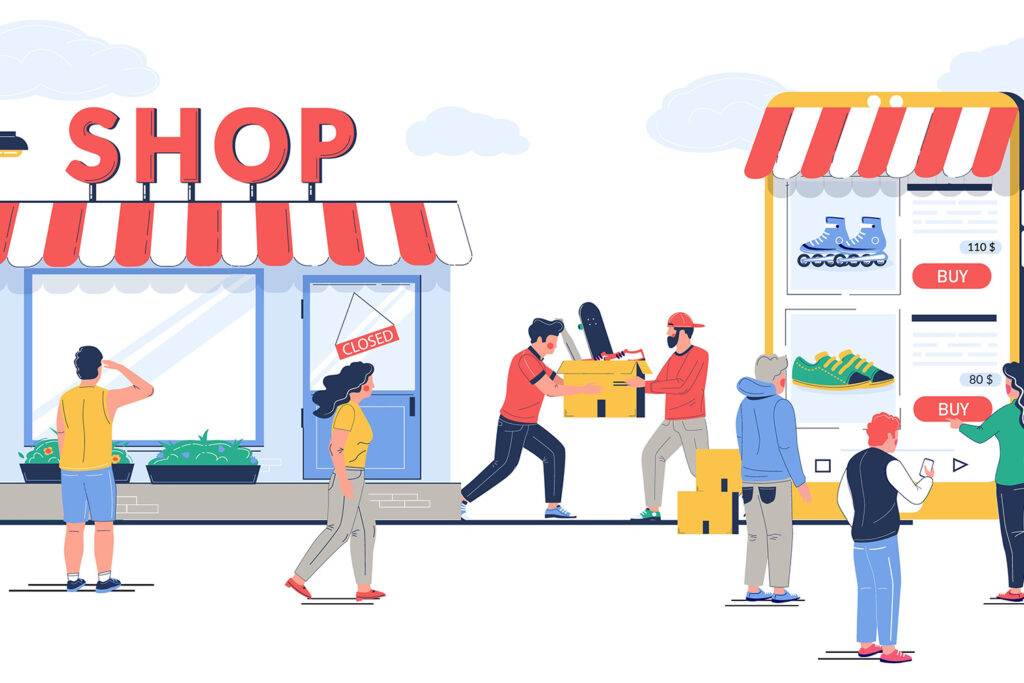People are constantly debating whether ecommerce or retail reigns supreme. The truth is that the standings are constantly changing and evolving.
If you want your business to be able to keep up with these changes, here’s what you need to know about ecommerce and retail:
What Is Ecommerce?
Ecommerce involves selling products online rather than in a physical store. Customers browse for products, select items, and complete purchases all online. From there, the order is shipped from a warehouse to the customer — usually in a matter of days.
What Is Retail?
Retail, on the other hand, involves selling products within a brick-and-mortar storefront. Customers can see and feel products before they buy them. They are also able to ask in-store associates any questions they have about products before making a purchase. From there, they can take their purchases home with them immediately.
Ecommerce vs. Retail: Pros and Cons
Every business decision comes with pros and cons — ecommerce and retail are no exception. Let’s weigh some of these pros and cons so that you can make the best choice for your business:
Ecommerce
The pros of ecommerce include:
- Low initial investment. Ecommerce requires a relatively low initial investment since you don’t need to invest in renting or purchasing an actual storefront. Instead, you just need to invest in an online platform for your store — many of which are quite economical.
- Convenience. Ecommerce is one of the most convenient shopping options out there since you can browse and purchase items from anywhere at any time — including your couch at midnight. All you need is an internet connection, and you’re good to go!
- Higher profit margins. Ecommerce offers higher profit margins since you’re not paying for a storefront, multiple sales associates, utilities, etc. Instead, all you need is your online store, and you’re good to go.
The cons of ecommerce include:
- Waiting for delivery. With ecommerce, you aren’t able to instantly obtain items as you can with retail. Instead, you have to place an order and wait for it to arrive. Sometimes it can take several days for your item to arrive.
- Can’t try anything on or out. With ecommerce, you can’t physically try on or examine any items before you buy them. Instead, you have to risk ordering items and potentially return them if they aren’t what you expected.
- Lacking customer service. With ecommerce, it can be difficult to get a level of customer service that rivals retail. Instead of speaking with someone face to face, you’re left to either chat, text, email, or speak with someone over the phone.
Retail
The pros of retail include:
- Instant gratification. With retail, you don’t have to wait days or even weeks for your items to arrive. Instead, you simply head to the store, pick out your items, and bring them home with you.
- Hands-on shopping. With retail, you truly get a hands-on shopping experience. You’re able to look and feel items before you purchase them. You’re also able to try on clothes to ensure they fit properly.
- Human touch. With retail, you get customer service with a human touch. It’s often easier to ask questions and get answers face-to-face.
The cons of retail include:
- High initial investment. Retail requires a relatively high initial investment since you have to purchase or rent physical space for your store. Even though commercial real estate is still on the rebound from COVID, prices are still quite high. In addition to the actual space, you also have to pay for equipment, including racks, shelves, and cash registers.
- Lower profit margins. Since you’re paying for things like rent, employees, electricity, etc., within retail, your profit margins are going to be lower than if you were exclusively operating online.
- Less convenient. Retail can be a less convenient shopping option since it’s not always available. Furthermore, you have to go to the store to shop physically.
Should You Expand Into Ecommerce?
There are benefits to ecommerce. But is this an area that’s worth expanding into? Here are some important ecommerce insights you need to know:
- In 2019, ecommerce sales made up 12.4% of all sales — a percentage that is increasing every year.
- 95% of purchases are expected to be through ecommerce by 2040.
- Everyone loves ecommerce — 79% of Americans purchased goods and services online in 2018
- In 2017, 40% of Internet users in the United States reported that they frequently purchase items online at least several times a month, with 20% reporting that they shopped online weekly
How to Expand Into Ecommerce
It’s easy to expand into ecommerce if you know what steps to take. Here are the four steps you need to take if you want to expand your business operations and start taking advantage of the booming ecommerce industry:
Step 1: Decide on an Online Platform
First of all, you need to decide on an online platform to host your ecommerce store. There are countless options to choose from, but the most popular one by far is Shopify. Shopify’s platform comes with hundreds of built-in features that you can use to build a successful online store.
One of Shopify’s best features is that it allows for multi-platform selling. For instance, you can easily list and sell your products across Facebook, Instagram, Amazon, and eBay. Since Shopify is such a large platform that powers over 800,000 businesses, its customer service is top-notch. Assistance is available 24/7 for any issues or questions that you may have along the way.
Step 2: Design Your Online Store
Once you have decided on a platform for your ecommerce store, you can start the building and design processes. Most online platforms have pre-made templates that you can select and customize to your liking. Some of these templates may even be free for you to use, depending on the platform.
On the other hand, if you have a gift for design, you can still create your template from scratch and completely customize it to meet your needs.
Step 3: Upload Your Products
Now it’s time to upload your products. Before you do this, make sure that your platform can handle your inventory. For example, if you have more than 1,000 products, certain platforms can be an issue.
When uploading your products, make sure that you’re as detailed and informative as possible so that customers feel confident in completing the purchase. You will need to include high-quality photos of your products from all angles.
It also helps to include photos that show the scale of your products. You will also need to include relevant information regarding product specifications and dimensions.
Step 4: Utilize an Omnichannel Approach
While you may think that your ecommerce transition is complete, it’s just beginning. For the best ecommerce results, you should utilize an omnichannel approach. With an omnichannel approach, you integrate multiple different sales and marketing channels for a seamless customer experience.
The good news is that you’re already well on your way toward an omnichannel approach with your ecommerce website. Now you just need to get involved in other channels so that you can reach your customers as effectively as possible.
Here are some channels that you should consider for your ecommerce business to be considered “omnichannel:”
- Mobile application: In addition to your desktop website, you may want to consider creating a mobile application. People are constantly on their phones, and with a mobile application, you can meet customers where they’re spending their time. Customers should be able to browse products and make purchases on your mobile application.
- Social media platforms: The next step involves creating business profiles on a variety of different social media platforms. Depending on your customer base, you may want to consider getting on popular platforms like Facebook, Instagram, Twitter, Snapchat, Pinterest, and TikTok.
- Email and SMS: If you want to stay in touch with your customers and communicate with them in a more personal manner, you should consider branching out into email and SMS marketing.
- Live chat and chatbots: To expand your customer service offerings, you should feature live chat capabilities or chatbots on your website so that your customers can easily get their questions answered at any time and prevent complaints.
- Branded content: Finally, you need to publish branded content to build your online authority and your search engine optimization (SEO) to rank higher on Google.
Ecommerce vs. Retail Wrap Up
Based on what we know now, ecommerce is going to continue to grow. If you want your business to grow along with it, you need to expand your operations. For expert guidance and advice on making this happen, reach out to Greg Gillman — a direct-to-consumer brand growth expert.
Sources:
The Pros & Cons of a Retail Store vs. an Online Store | Small Business Chron
Global E-Commerce Sales to Hit $4.2 Trillion as Online Surge Continues, Adobe Reports | Forbes


